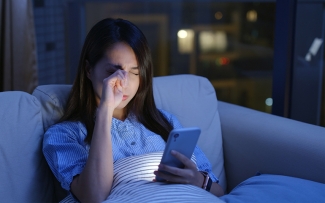The damaging effect of digital devices on eyes
As we swiftly move into the digital age, we are becoming increasingly dependent on digital devices. From TVs and computers to smartphones and tablets, there are more ways for children to interact with digital technology both in education and play than ever before. But are kids spending too long looking at screens and if so, what effect is this having on their health?
We conducted a survey of 2,000 parents in the UK with children aged between the ages of 2 and 16, to see which digital devices children use and how regularly they use them.
Children and digital devices – How concerned should we be?

Photo by Pinho . on Unsplash
How long do children spend using digital devices?
Digital devices are everywhere; from using computers at school, to watching TV at home or playing games on a smartphone. Almost half of the parents we surveyed agreed that their children were spending too much time using digital devices and said that 1-2 hours each day was an acceptable amount of time. But our findings show the actual time that children spend using digital devices may be significantly more than previously thought.
According to our survey, children are spending an average of one hour per day on each of the following devices: personal computer, digital tablet (such as an iPad), games console and smartphone. They are also estimated to spend just over half an hour each on their e-readers (such as a Kindle), their MP3 players and on electronic learning devices. This is all on top of watching almost two hours of TV. Collectively, that’s over seven hours that children are spending looking at screens every day.

Photo by Tim Gouw on Unsplash
How many children own a digital device?
Gone are the days when families shared one computer or sat around the TV in the living room. But it might be surprising to learn that as many as 39% of parents we surveyed said that their children owned a tablet and 38% said their children owned a smartphone.
Why is this an issue?
With greater access to digital devices than any other generation before, it’s only natural that kids are turning to tablets and laptops for both work and play whenever they can. But when we look at an object at close range, our eyes work much harder to focus than they would if we were looking at something at a longer distance. Looking at electronic screens for lengthy periods of time means that our eyes are constantly trying to bring the images or text on screen into focus, which can make us feel tired and drained.

Photo by Grzegorz Walczak on Unsplash
What are the long-term effects?
The vast amount of time children spend behind a screen each day would give any parent cause for concern. Our survey found that 66% of parents were worried about overuse of digital devices, with a further 60% specifically worried about the effect that the overuse of digital devices would have on their children’s eyesight.
One of the most common side effects of using digital devices for long periods of time is Digital Eye Strain. This can be caused by staring too closely at screens. Another potential cause is high-energy visible light (HEV), emitted by devices such as tablets and smartphones. Frequent exposure to HEV, particularly at night, can cause vision to deteriorate over time.
We asked optical expert Rob Hogan, a registered optometrist for over 33 years, for his thoughts on screen time before bed: “It is important to limit access just before bedtime, as research has found that the background ‘blue-ish’ light typically emitted from these devices can disrupt normal sleep patterns. Also, blue light chronically absorbed throughout life is implicated in Age-related Macular Degeneration (AMD), increasingly found in later life.”
Of course, with the huge growth of smartphone and tablet usage still being quite a recent phenomenon, we’ve yet to fully understand the effects.
What are the other effects of too much screen time?

Photo by Matias Islas on Unsplash
Although very rare, excessive use of digital devices can lead to more serious issues, including behavioural problems, attention deficit disorder and eye strain. This can cause issues in later life. Computer Vision Syndrome (CVS) is one potential condition, more common for adults, which may arise due to screens. The symptoms of CVS include blurred vision, fatigue, headaches, and difficulty focusing. In addition, some people experience back, neck and shoulder pain from hunching over to look at small screens and focus on small text.

How can we prevent damage caused by screens?
Smartphones, tablets, laptops and TVs have become an intrinsic part of modern life for both adults and children. So it’s not surprising that the problems associated with too much screen time can go unnoticed.
Many of the parents we surveyed said they were unsure as to what they could do to prevent the harmful effects of digital devices on their children’s health. But parents can take precautionary measures to limit the time spent on phones and laptops. Dr Rob Hogan provided some more advice for parents.

Photo by Yiran Ding on Unsplash
Dr Rob Hogan’s top tips
Dr Rob Hogan has been a registered optometrist for over 33 years and has spent over 20 years directing and managing professional services for some of the largest optometric companies in the UK. He is also a member of the General Optical Council (GOC), the biggest governing optical body in the UK. So, it’s safe to say he knows a thing or two about eyes!
Take your child for regular eye checks
A child’s vision is critical to their learning and development. Making regular checkups with an optometrist is essential. In the UK, all children under the age of 16 are entitled to free sight tests with the NHS. Whilst a child can be seen at any age, they are most typically tested in an opticians’ practice from around the ages of 3-4. Make sure you let the optometrist know about any family history of eye or vision problems.
When using a computer, place a light source behind you.
When you or your child is using a laptop or tablet, avoid placing a light source behind the screen, as your eyes will struggle to adjust to the two competing light sources. Instead, place your lamp to the side or behind you to avoid discomfort and eye strain.
Always sit at an arms’ distance away from your screen.
Sitting too close to a screen can cause discomfort, stress and strain on your eyes and can be a sign that your child is developing short-sightedness or Myopia. To prevent this, always sit at least an arm’s length away from your screen. If you notice your child sits closer and is displaying signs of eye discomfort, they may require some form of vision correction, and we would advise that you book an appointment with your local optician.
Every 20 minutes spent staring at a screen; spend 20 seconds looking at something 20ft away.
The 20/20/20 rule (for every 20 minutes spent on a digital device, spend 20 seconds looking at something 20 feet away) can be difficult to monitor in children. Designating a specific time period for digital use with intermittent activities arranged between these times will give your child’s eyes a break.
All optometrists also recommend swapping a digital screen for the pleasures of the great outdoors to improve a child’s eye health and general wellbeing. After all, it’s the best way for your kids to discover the world around them!
Book an appointment with an optician if you have any concerns about your screen time and your eyes. If you are already a Lenstore customer you are entitled to a free appointment with Vision Express (book your appointment here). If you find that your eyes are feeling tired when using screens have a look at our range of eye drops to help alleviate your problem.



